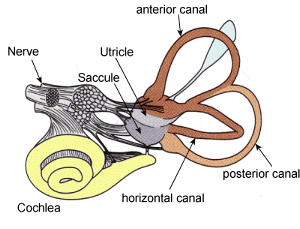No matter what your level of experience with psychology is, you have probably heard of the five basic senses, which consist of the visual, auditory (hearing), gustatory (taste), olfactory (smell), and somatosensory (touch) systems. However, recent advances in science have expanded this canonical list of five sense systems to include two more: proprioception, which is the sense of the positioning of parts of the body; and the vestibular system, which senses gravity and provides balance.
Proprioception and Kinesthesia
Proprioception is the sense of the relative positioning of neighboring parts of the body, and sense of the strength of effort needed for movement. It is distinguished from exteroception, by which one perceives the outside world, and interoception, by which one perceives pain, hunger, and the movement of internal organs. A major component of proprioception is joint position sense (JPS), which involves an individual's ability to perceive the position of a joint without the aid of vision. Proprioception is one of the subtler sensory systems, but it comes into play almost every moment. This system is activated when you step off a curb and know where to put your foot, or when you push an elevator button and control how hard you have to press down with your fingers.
Kinesthesia is the awareness of the position and movement of the parts of the body using sensory organs, which are known as proprioceptors, in joints and muscles. Kinesthesia is a key component in muscle memory and hand-eye coordination. The discovery of kinesthesia served as a precursor to the study of proprioception. While the terms proprioception and kinesthesia are often used interchangeably, they actually have many different components. Often the kinesthetic sense is differentiated from proprioception by excluding the sense of equilibrium or balance from kinesthesia. An inner ear infection, for example, might degrade the sense of balance. This would degrade the proprioceptive sense, but not the kinesthetic sense. The affected individual would be able to walk, but only by using the sense of sight to maintain balance; the person would be unable to walk with eyes closed. Another difference in proprioception and kinesthesia is that kinesthesia focuses on the body's motion or movements, while proprioception focuses more on the body's awareness of its movements and behaviors. This has led to the notion that kinesthesia is more behavioral, and proprioception is more cognitive.
The Vestibular System
The vestibular system is the sensory system that contributes to balance and the sense of spatial orientation. Together with the cochlea (a part of the auditory system) it constitutes the labyrinth of the inner ear in most mammals, situated within the vestibulum in the inner ear.
There are two main components of the vestibulum: the semicircular canal system, which indicates rotational movements; and the otoliths, which indicate linear accelerations. Some signals from the vestibular system are sent to the neural structures that control eye movements and provide us with clear vision, a process known as the vestibulo-ocular reflex. Other signals are sent to the muscles that control posture and keep us upright.

The inner ear and the vestibular system
The vestibular system, together with the cochlea, makes up the workings of the inner ear and provides us with our sense of balance.
Proprioception vs. Vestibular System
While both the vestibular system and proprioception contribute to the "sense of balance," they have different functions. Proprioception has to do with the positioning of limbs and awareness of body parts in relation to one another, while the vestibular system contributes to the understanding of where the entire body is in space. If there was a problem with your proprioception, you might fall over if you tried to walk because you would lose your innate understanding of where your feet and legs were in space. On the other hand, if there was a problem with your vestibular system (such as vertigo), you might feel like your entire body was spinning in space and be unable to walk for that reason.